I need to make two slight clarifications to my Review of the 26 Blocks Show. My interpretation of Chris Loomis‘ photograph was a bit off. Joey Robert Parks, the creator of the 26 Blocks Project, filled me in on the details of how Chris accomplished this photograph. There was no camera “trickery” involved. Rather, a lot of forethought and planning to turn a vacant dirt lot into a work of art. Knowing the process behind this photograph brings about a new appreciation for the finished work for me.
What I said “appears” to be was indeed reality. The girl was in the lot and the “crop circles” were a photographer’s painstaking work to get the perfect shot. Very admirable. From Joey:
There is no photographic trick going on. The woman is not Photoshop. She’s actually standing there in the dirt lot. The crop circle took Chris seven hours to make. He did it all by himself.
I had also indicated that it appeared Chris Loomis had captured the image from high above. In fact it is not just appearances, it was taken from high above. Very high in fact. Again from Joey:
It *was* taken from high above. From a helicopter, in fact. How’d he get such a clear shot? He steadied the camera only with his hands. No mini-gyro stabilizing equipment used.
I stand by my original statement that “The artist saw what was and turned it into his own vision through photography.” But need to append it: “…through photography, creative vision and a lot of hard work.”
Thanks for clarifying Joey.
Read more about Chris Loomis’ Block E and the entire 26 Blocks project at 26blocks.com or in an article printed in the AZ Republic in May.
I did some portrait photography of my dogs this past weekend. Here are a few tips I picked up through trial and error for better pet portrait photographs.
1) Animals work on their terms and their schedules. If you think high maintenance models are difficult to work with try a dog. Anticipate potty breaks mid shoot and playing with rather than posing with the props. Bottom line, they are animals patience is critical.
2) As with human portraits lighting is very important. It really helps to have studio lighting but I am sure you can improvise with natural window light or some combination of natural and artificial light.
3) Animals don’t take posing directions too well so they are going to move; sometimes quickly. The right camera settings will not help with the squirmiest pet but they can help combat some movement. Ideally you want to keep your shutter speed no slower then 1/60 but if you can bump the speed up to 1/125 even better. A larger aperture will allow you to keep the shutter speed fast and give you a shallow depth of field to blur the background. As for ISO you want to keep it low to avoid noise.




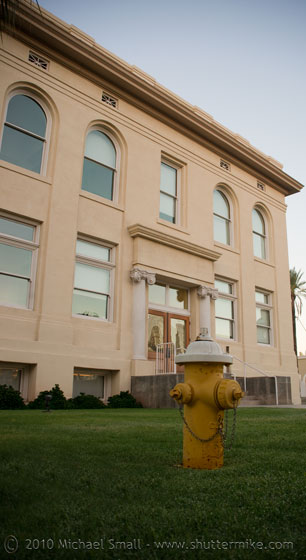
Phoenix Union High School
f/8.0 – 1/30 sec – ISO 250 – Focal Length 28 mm
Built in 1911 in Phoenix on Van Buren between 7th and 3rd streets, the Phoenix Union High School served the city for many decades. After the campus sat unoccupied for several years the University of Arizona converted it into the new Phoenix campus of the College of Medicine. The old buildings appear much as they did in 1911. Additional space required by the college was added on as very modern architecture to clearly distinguish it as 21st century. The old was merged with the new while maintaining the uniqueness of each.
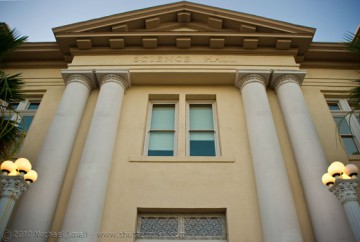 Update: Be sure to read an update to this post with more detail on how the photographers created their pieces here.
Update: Be sure to read an update to this post with more detail on how the photographers created their pieces here.
26 Blocks is an art project that “…showcases the work of 26 of Metro Phoenix’s best photographers working with 26 of Metro Phoenix’s best writers.” They worked together to offer their interpretation of one of 26 downtown Phoenix city blocks through photography and the written word. Then the sculptor, Rafael Navarro, topped off each presentation with a 4″ x 4″ square block sculpture of each block. The exhibit began at the After Hours Gallery in Downtown Phoenix last month and in now starting a tour of venues around the city. I missed the opening at After Hours but was able to see the exhibit at the University of Arizona College of Medicine’s downtown Phoenix campus last Thursday, the first stop on its city tour.
The College of Medicine show was not in a normal gallery space. Rather it was in the auditorium of the old Phoenix Union High School that has been renovated and now houses the college. As a result a traditional gallery layout was not possible. So each city block’s pieces were propped up on tables around the large auditorium room. I do not think the unconventional setting distracted from the works however. In fact, the history of the old high school building now having been re-purposed and given a new life, almost added another layer to the stories of the Phoenix city blocks being told through these photographers, writers and sculptor.
One of the most interesting aspects of this show was the unique interpretations each pair had of their individual city blocks. Blocks that may not have been separated by more than one street could seem miles away as each photographer and writer approached them from very unique perspectives and visions.
The photography ranged from the very straightforward architectural and portrait to much more abstract interpretations involving post-processed works.
Two that stood out as favorites to me were Block E from photographer Chris Loomis and Block V from Stephen G. Dreiseszun.
Chris’ photograph of Block E, the lot of dirt that splits 3rd St into two separate lanes to the east and west of it, just south of Roosevelt, stood out to me for two reasons. 1) It was a bit more on the abstract side and 2) whereas most of the other lots were developed and alive with urban life, this lot was in more of a “what once was” state being dirt and foundations of former structures. So some creative license had to be taken to make an image out of a vacant lot. Appearing as though it was taken from high above, crop-circle like shapes fill the dirt and weeded lot while a girl in bright blue appears to be dancing inside the shapes. Chris’ photograph is a great example of the art of photography to me. The artist saw what was and turned it into his own vision through photography.
Stephen Dreiseszun’s photograph of Block V was very different than Block E. Block V encompasses the construction site between Washington and Jefferson on the North and South and 1st Ave and Central Ave. on the West and East. The very urban scene of high rise construction was captured by Stephen beautifully. The lighting of late evening makes the sky a deep, rich blue while the lights of the street sign and construction crane highlight these urban elements. The perspective captured in the photography for Block V is one that the casual passer by may not take the time to notice. But this image captures what I feel the 26 Blocks project is all about, seeing urban downtown Phoenix at more than everyday street level views and taking the time to stop and notice the subtle beauty of the built environment.
The pairing of two art forms, photography and writing, has resulted in a show that speaks to a broad audience. The art lover, the lover of the written word, the urban dweller, the suburban admirer of the urban environment and fans of a diverse and dynamic city such as Phoenix.
26 Blocks is on Tour through the remainder of the year at venues around the Valley. This is a unique project that is well worth seeing regardless of which of those categories you fall into, or even if you fall far outside of those categories. Check for tour dates and locations and make sure you see the 26 Blocks exhibit before it is gone.
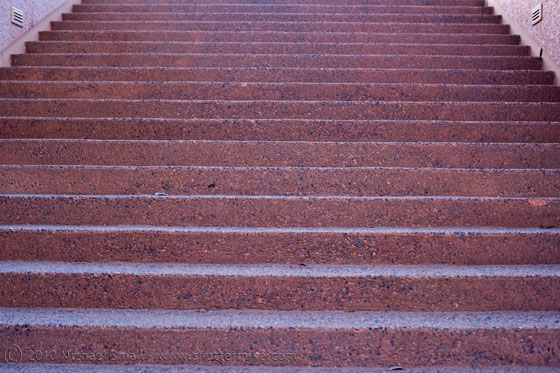 Up the Pink Stairs
Gammage Auditorium
Arizona State University – Tempe, AZ
Up the Pink Stairs
Gammage Auditorium
Arizona State University – Tempe, AZ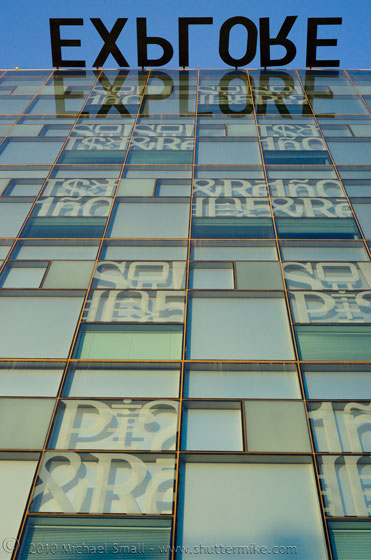
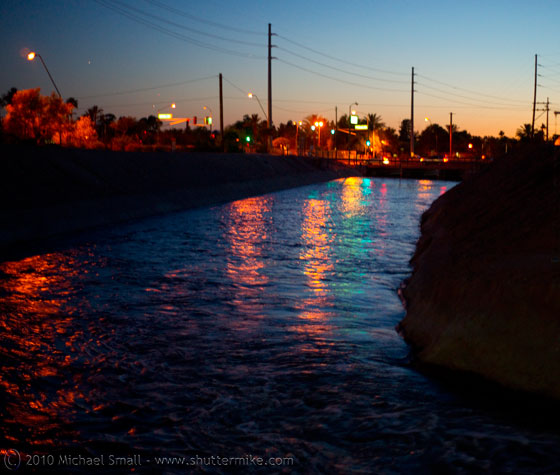





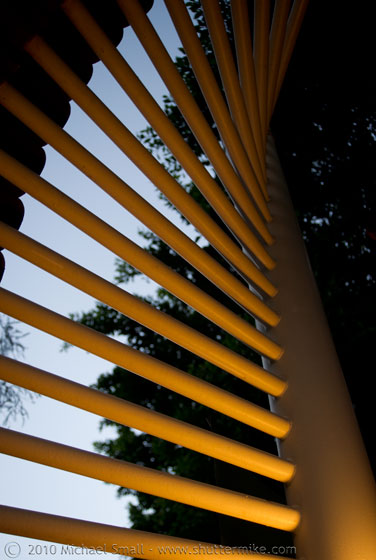 Repeating Lines
f/4.5 – 1/25 sec – ISO 200 – Focal Length 45 mm
Repeating Lines
f/4.5 – 1/25 sec – ISO 200 – Focal Length 45 mm

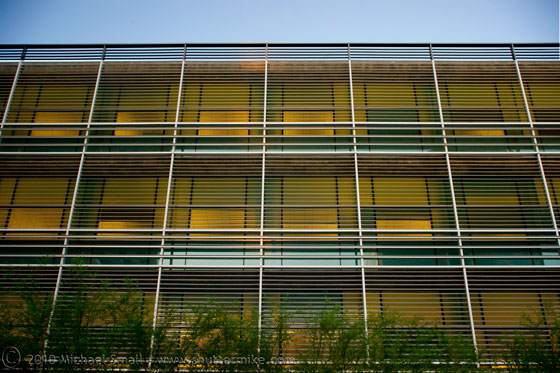 Lines
Downtown Phoenix, AZ
Lines
Downtown Phoenix, AZ



